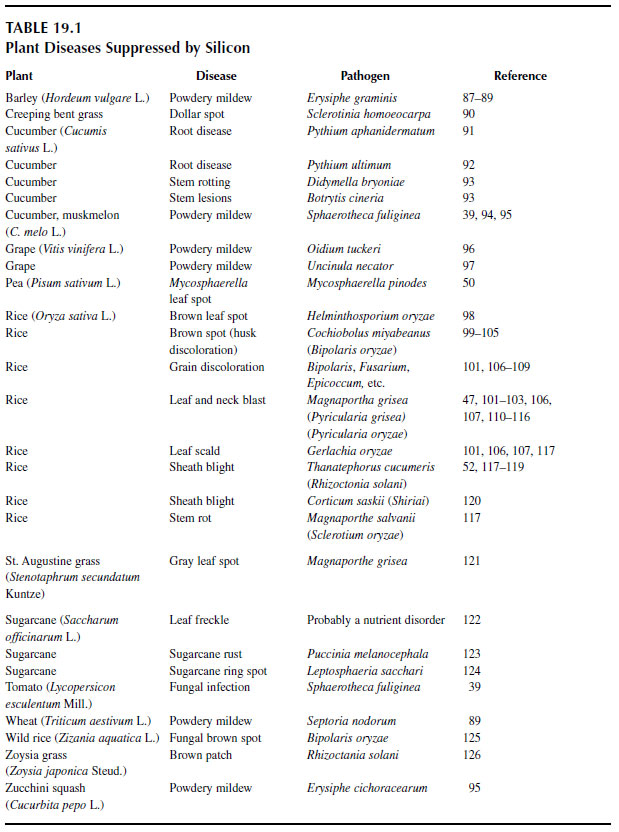Beneficial Effects of Silicon in Plant Nutrition
Effect of Silicon on Biotic Stresses
Silicon has been found to suppress many plant diseases (Table 19.1) and insect attacks (Table 19.2). The effect of silicon on plant resistance to pests is considered to be due either to accumulation of absorbed silicon in the epidermal tissue or expression of pathogensis-induced host-defense responses. Accumulated monosilicic acid polymerizes into polysilicic acid and then transforms to amorphous silica, which forms a thickened silicon–cellulose membrane (44,45), and, which can be associated with pectin and calcium ions (46). By this means, a double-cuticular layer protects and mechanically strengthens plants (9) (Figure 19.2). Silicon might also form complexes with organic compounds in the cell walls of epidermal cells, therefore increasing their resistance to degradation by enzymes released by the rice blast fungus (Magnaporthe grisea M.E. Barr) (47). Indeed, silicon can be associated with lignin–carbohydrate complexes in the cell wall of rice epidermal cells(48).
 |
Research also points to the role of silicon in plants as being active and suggests that the element might be a signal for inducing defense reactions to plant diseases. Silicon has been demonstrated to stimulate chitinase activity and rapid activation of peroxidases and polyphenoxidases after fungal infection (49). Glycosidically bound phenolics extracted from amended plants when subjected to acid or �-glucosidase hydrolysis displayed strong fungistatic activity. Dann and Muir (50) reported that pea (Pisum sativum L.) seedlings amended with potassium silicate showed an increase in the activity of chitinase and �-1,3-glucanase prior to being challenged by the fungal blight caused by Mycosphaerella pinodes Berk. et Blox. In addition, fewer lesions were observed on leaves from silicon- treated pea seedlings than on leaves from pea seedlings not amended with silicon. More recently, flavonoids and momilactone phytoalexins were found to be produced in both dicots and monocots, respectively, and these antifungal compounds appear to be playing an active role in plant disease suppression (51,52).
 |
 |
| FIGURE 19.2 Schematic representation of the rice (Oryza sativa L.) leaf epidermal cell. (From S. Yoshida, Technical bulletin, no. 25, Food and Fertilizer Technology Center, Taipei, Taiwan, 1975.) |
Effect of Silicon on Abiotic Stresses
Silicon deposits in cell walls of xylem vessels prevent compression of the vessels under conditions of high transpiration caused by drought or heat stress. The silicon-cellulose membrane in epidermal tissue also protects plants against excessive loss of water by transpiration (53). This action occurs owing to a reduction in the diameter of stomatal pores (54) and, consequently, a reduction in leaf transpiration (15).The interaction between monosilicic acid and heavy metals, aluminum, and manganese in soil (discussed below) helps clarify the mechanism by which heavy metal toxicity of plants is reduced (55,56).
Silicon may alleviate salt stress in higher plants (57,58). There are several hypotheses for this effect. They are (a) improved photosynthetic activity, (b) enhanced K/Na selectivity ratio, (c) increased enzyme activity, and (d) increased concentration of soluble substances in the xylem, resulting in limited sodium adsorption by plants (58-61).
Proper silicon nutrition can increase frost resistance by plants (58,62). However, this mechanism remains poorly understood.




